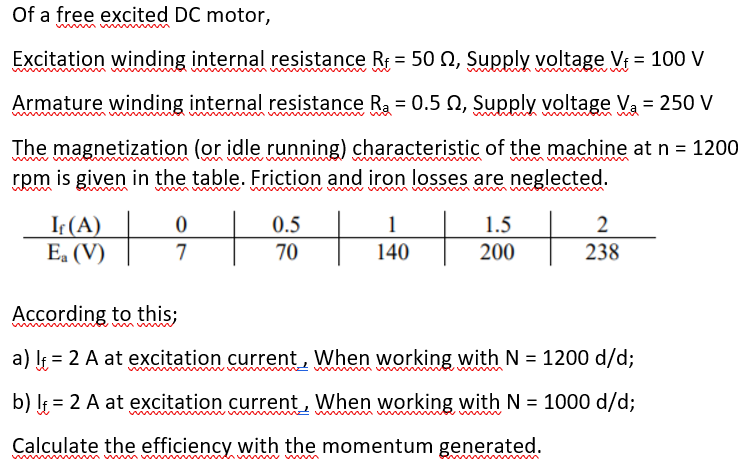Of a free excited DC motor, Excitation winding internal resistance R = 50 N, Supply voltage Vr = 100 V Armature winding internal resistance Ra = 0.5 N, Supply voltage Va = 250 V The magnetization (or idle running) characteristic of the machine at n = 1200 rpm is given in the table. Friction and iron losses are neglected. wwww Ir (A) E. (V) 0.5 1 1.5 2 7 70 140 200 238 According to this; a) If = 2 A at excitation current , When working with N = 1200 d/d; b) !; = 2 A at excitation current , When working with N = 1000 d/d; %3D www
Of a free excited DC motor, Excitation winding internal resistance R = 50 N, Supply voltage Vr = 100 V Armature winding internal resistance Ra = 0.5 N, Supply voltage Va = 250 V The magnetization (or idle running) characteristic of the machine at n = 1200 rpm is given in the table. Friction and iron losses are neglected. wwww Ir (A) E. (V) 0.5 1 1.5 2 7 70 140 200 238 According to this; a) If = 2 A at excitation current , When working with N = 1200 d/d; b) !; = 2 A at excitation current , When working with N = 1000 d/d; %3D www
Introductory Circuit Analysis (13th Edition)
13th Edition
ISBN:9780133923605
Author:Robert L. Boylestad
Publisher:Robert L. Boylestad
Chapter1: Introduction
Section: Chapter Questions
Problem 1P: Visit your local library (at school or home) and describe the extent to which it provides literature...
Related questions
Question
Example-2
Thank you

Transcribed Image Text:Of a free excited DC motor,
Excitation winding internal resistance Rf = 50 0, Supply voltage V = 100 V
Armature winding internal resistance Ra = 0.5 N, Supply voltage Va = 250 V
The magnetization (or idle running) characteristic of the machine at n = 1200
rpm is given in the table. Friction and iron losses are neglected.
w mw
w w w mw
mwm m
Ir (A)
E. (V)
0.5
1
1.5
2
7
70
140
200
238
According to this;
a) = 2 A at excitation current, When working with N = 1200 d/d;
b) I; = 2 A at excitation current, When working with N = 1000 d/d;
Calculate the efficiency with the momentum generated.
wwwm
Expert Solution
This question has been solved!
Explore an expertly crafted, step-by-step solution for a thorough understanding of key concepts.
Step by step
Solved in 3 steps with 3 images

Knowledge Booster
Learn more about
Need a deep-dive on the concept behind this application? Look no further. Learn more about this topic, electrical-engineering and related others by exploring similar questions and additional content below.Recommended textbooks for you

Introductory Circuit Analysis (13th Edition)
Electrical Engineering
ISBN:
9780133923605
Author:
Robert L. Boylestad
Publisher:
PEARSON

Delmar's Standard Textbook Of Electricity
Electrical Engineering
ISBN:
9781337900348
Author:
Stephen L. Herman
Publisher:
Cengage Learning

Programmable Logic Controllers
Electrical Engineering
ISBN:
9780073373843
Author:
Frank D. Petruzella
Publisher:
McGraw-Hill Education

Introductory Circuit Analysis (13th Edition)
Electrical Engineering
ISBN:
9780133923605
Author:
Robert L. Boylestad
Publisher:
PEARSON

Delmar's Standard Textbook Of Electricity
Electrical Engineering
ISBN:
9781337900348
Author:
Stephen L. Herman
Publisher:
Cengage Learning

Programmable Logic Controllers
Electrical Engineering
ISBN:
9780073373843
Author:
Frank D. Petruzella
Publisher:
McGraw-Hill Education

Fundamentals of Electric Circuits
Electrical Engineering
ISBN:
9780078028229
Author:
Charles K Alexander, Matthew Sadiku
Publisher:
McGraw-Hill Education

Electric Circuits. (11th Edition)
Electrical Engineering
ISBN:
9780134746968
Author:
James W. Nilsson, Susan Riedel
Publisher:
PEARSON

Engineering Electromagnetics
Electrical Engineering
ISBN:
9780078028151
Author:
Hayt, William H. (william Hart), Jr, BUCK, John A.
Publisher:
Mcgraw-hill Education,